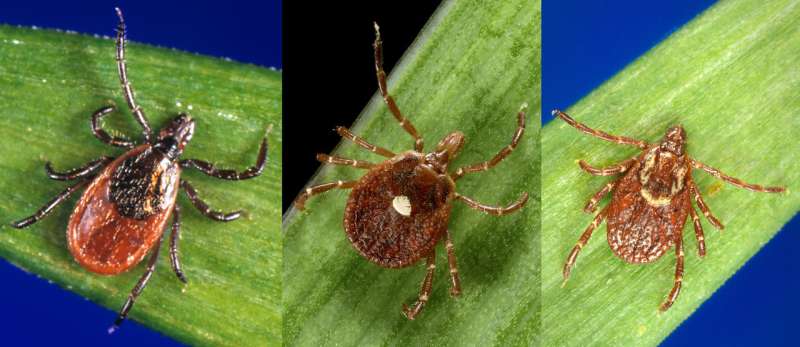Tick bite protection: New CDC study adds to the promise of permethrin-treated clothing

The case for permethrin-treated clothing to prevent tick bites keeps getting stronger.
In a series of experiments conducted by researchers at the U.S. Centers for Disease Control and Prevention, clothing treated with an insecticide known as permethrin had strong toxic effects on three primary species of ticks known to spread disease-causing pathogens in the United States. Exposure to permethrin interfered with the ticks' ability to move properly, making them sluggish and likely interfering with their ability to bite. This effect has been previously documented in just one tick species. The results of the study are published today in the Entomological Society of America's Journal of Medical Entomology.
Permethrin, a synthetic form of an insecticidal compound derived from the chrysanthemum flower, has been documented for its utility as protection against bites from ticks, mosquitoes, and flies since the late 1970s, but researchers continue to probe its effects on various species under varying conditions. Amid the ongoing geographic expansion of ticks in North America, a greater understanding of the effectiveness of consumer-based products for protection from ticks is necessary to combat the threat of Lyme disease and other human infections caused by tick-transmitted pathogens.
While previous research from the CDC has focused on permethrin's effects on the blacklegged tick (Ixodes scapularis), its latest study finds similar effects from permethrin on both the lone star tick (Amblyomma americanum) and the American dog tick (Dermacentor variabilis), as well, and it also found permethrin to have notable effects across both nymphal (juvenile) and adult life stages of the blacklegged tick and lone star tick.
Various garments (shirts, pants, and socks) produced by a leading manufacturer of permethrin-treated clothing were tested in the experiments, in which the researchers affixed portions of the clothing to flat surfaces and placed ticks on them. In some tests the surface was placed at a 45-degree angle and ticks were observed for their likelihood to let go and tumble off due to the irritant effect of permethrin. In other tests, the ticks were placed on level surfaces and contained for specific intervals (1-5 minutes) and then observed for their ability to move normally over the following 24 hours.
"All tested tick species and life stages experienced irritation—the 'hot-foot' effect—after coming into contact with permethrin-treated clothing," says Lars Eisen, Ph.D., research entomologist at the CDC's National Center for Emerging and Zoonotic Infectious Diseases and senior author on the study. "This caused the ticks to drop off from a vertically oriented treated textile designed to mimic a pant leg or the arm of a shirt. We also found that sustained contact with permethrin-treated clothing—up to 5 minutes—resulted in loss of normal movement for all examined tick species and life stages, leaving them unable to bite."
Effects varied somewhat between species. Permethrin-treated clothing showed the strongest effect on blacklegged tick nymphs (after a one-minute exposure, 100 percent lacked normal movement one hour later), followed by lone star tick nymphs (86 percent), blacklegged tick adult females (62 percent), American dog tick adult females (18 percent), and lone star tick adult females (2 percent). A five-minute exposure to permethrin-treated clothing led to loss of normal movement for all ticks of all three species and life stages for at least one hour.
Permethrin treatment is available in various forms to consumers. Certain manufacturers produce clothing pre-treated with permethrin. Other companies offer mail-and-return treatment through which consumers send clothing they already own to be treated with permethrin and returned. Alternatively, permethrin sprays are available for consumers to apply to their clothing on their own at home. The CDC recommends treatment for clothing and gear such as boots, pants, socks, and tents with products containing 0.5 percent permethrin and notes that it remains protective through multiple washings.
Ongoing and future research will seek to determine just how long various permethrin treatments last over time, wash cycles, and wearing conditions, Eisen says.
"Ultimately, we'd like to be able to provide more specific guidance about the use of permethrin-treated clothing, including what types of clothing provide the best protection. Additional research in this area can improve public health recommendations," he says.
More information: "Contact Irritancy and Toxicity of Permethrin-Treated Clothing for Ixodes scapularis, Amblyomma americanum, and Dermacentor variabilis Ticks (Acari: Ixodidae)," Journal of Medical Entomology (2018). DOI: 10.1093/jme/tjy062



















